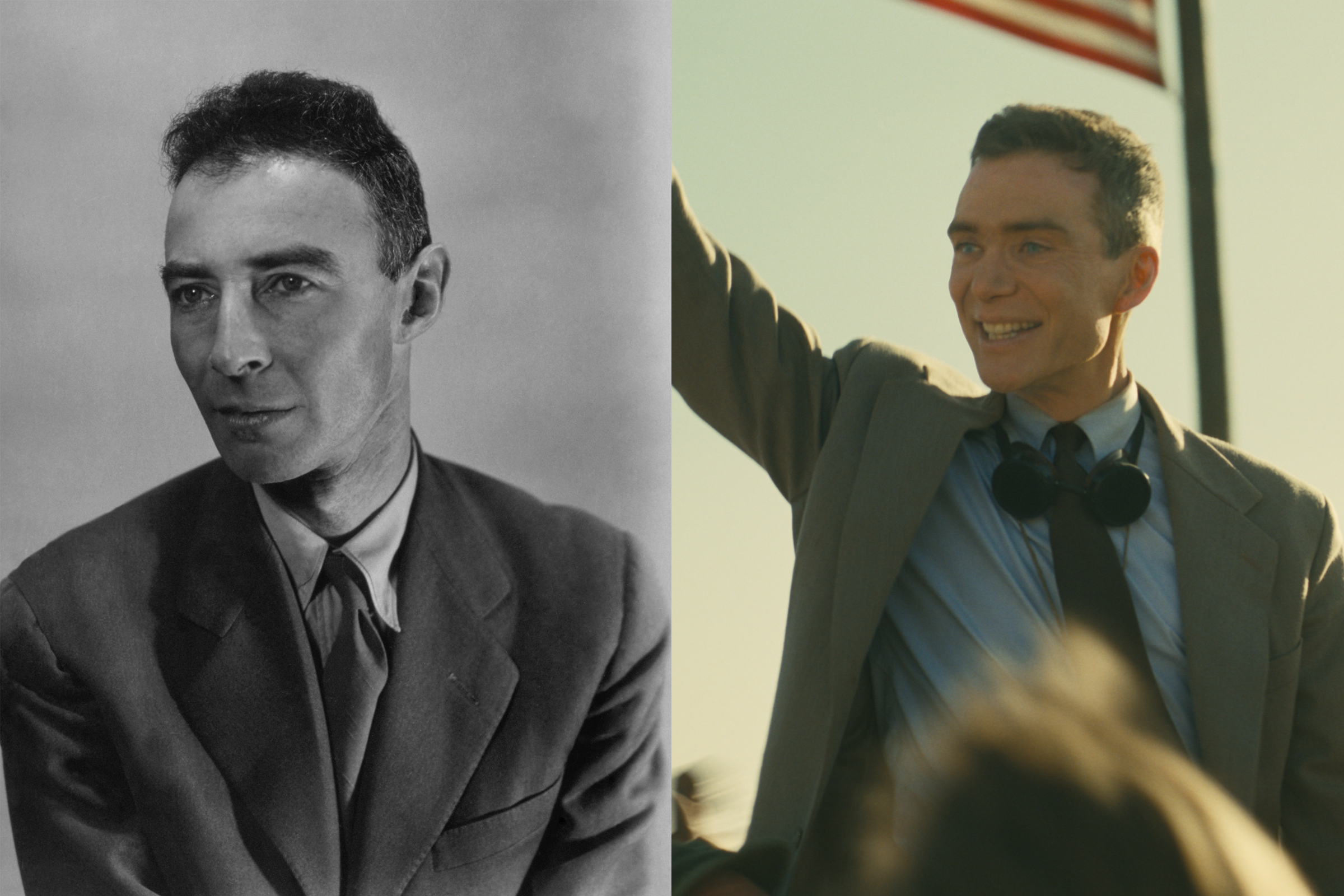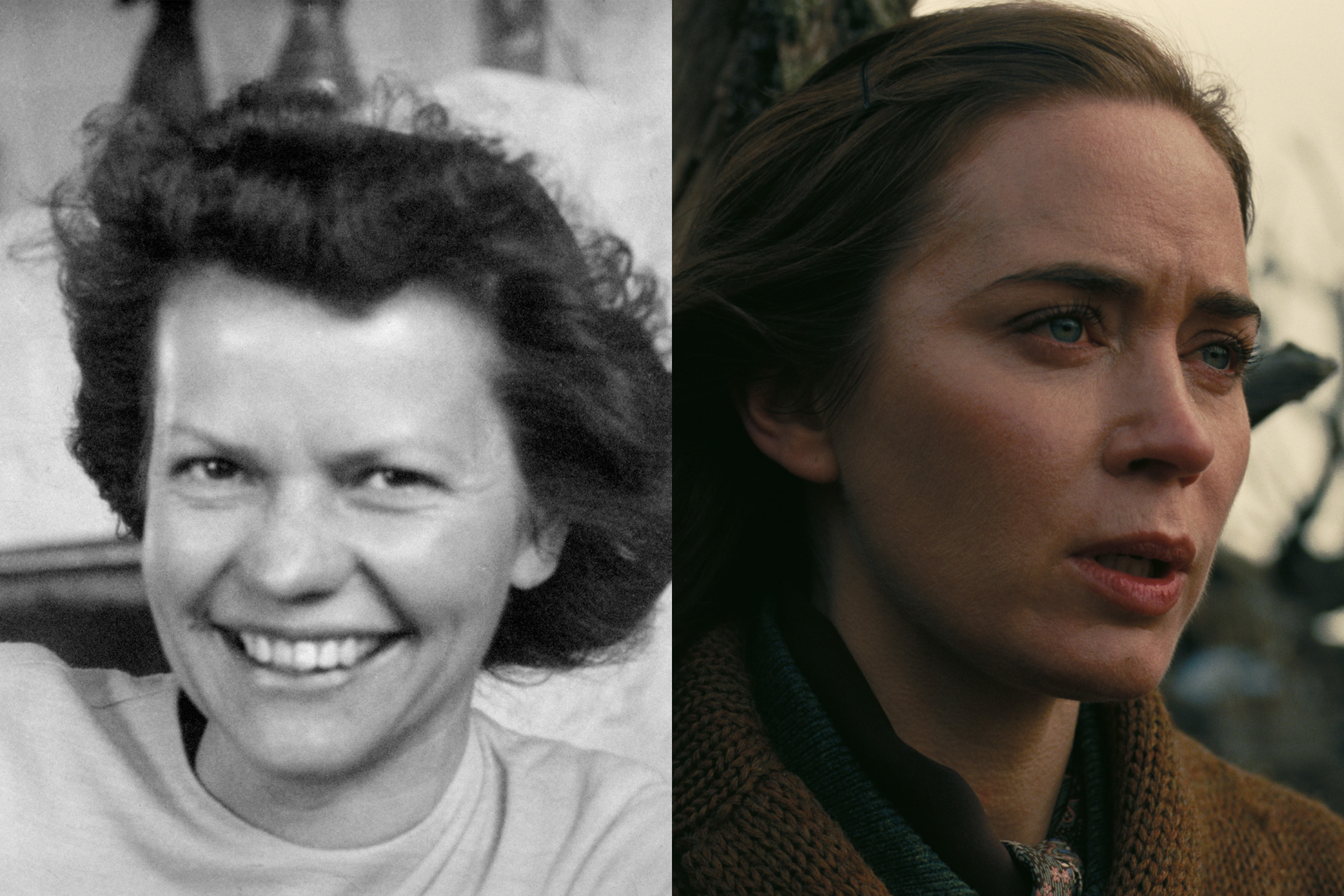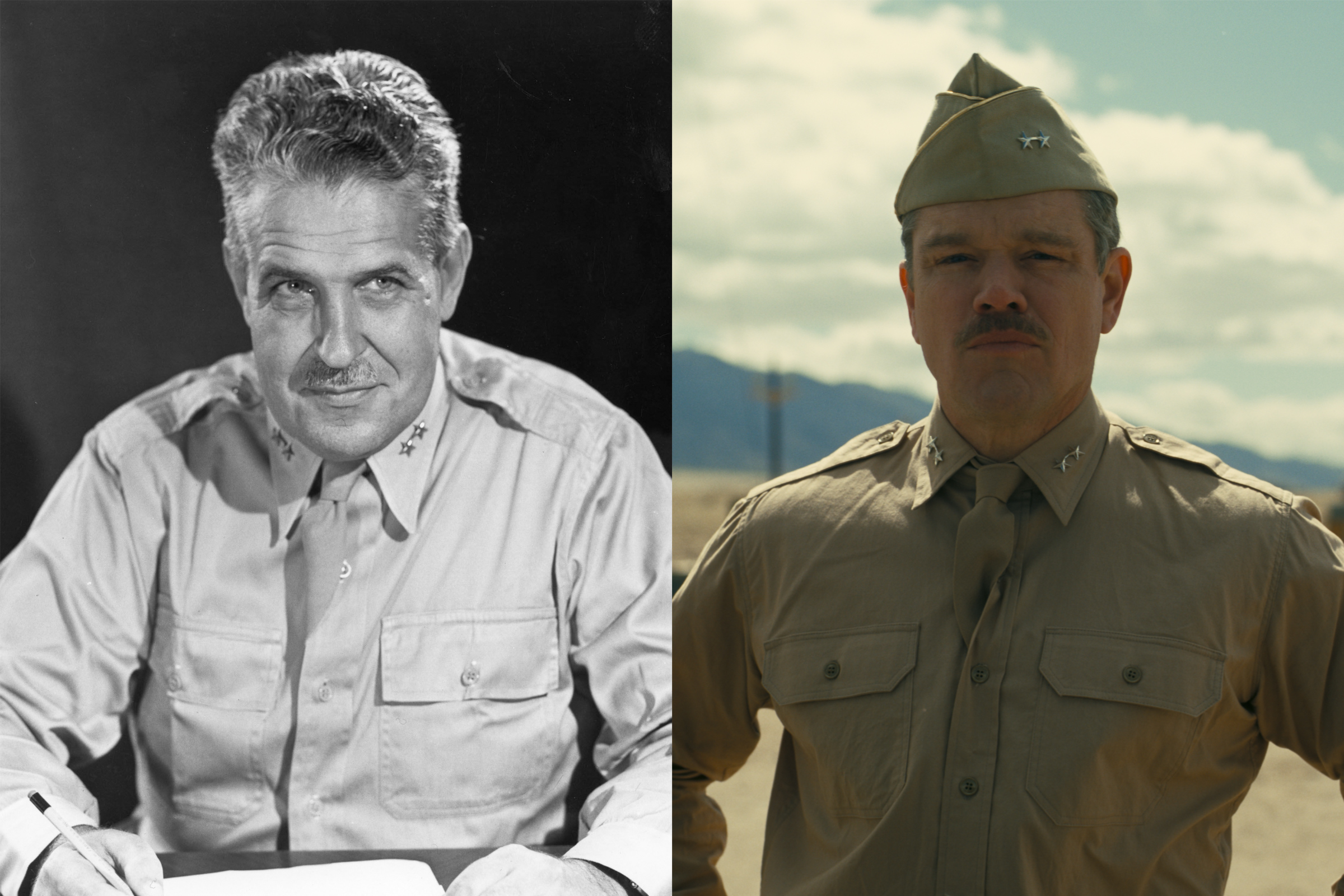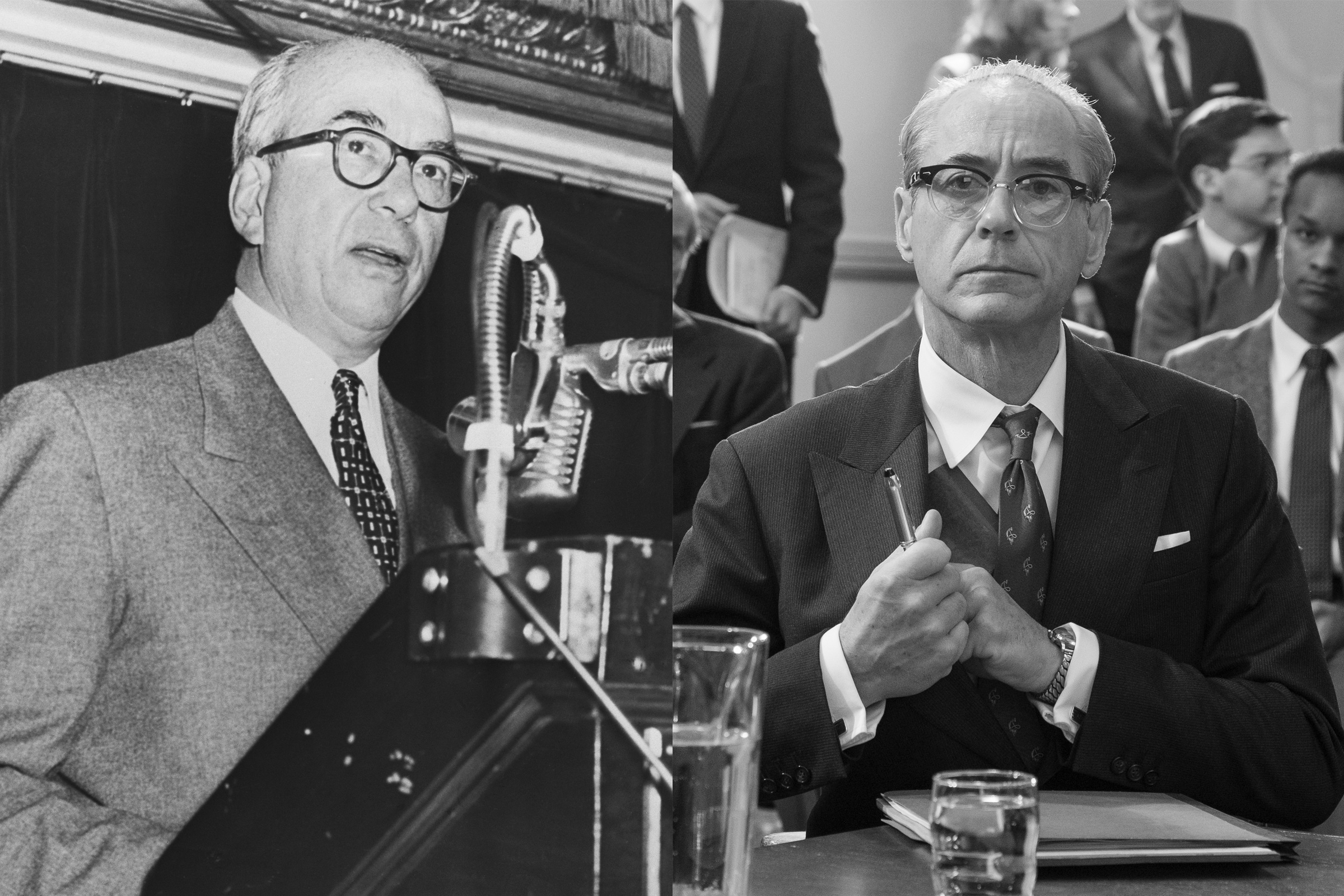After months of building anticipation, writer-director Christopher Nolan’s new movie Oppenheimer arrived in theaters Friday, kickstarting an opening weekend where it’s expected to collect around $50 million at the domestic box office.
The three-hour (and nine second) biopic centers, as its title suggests, on J. Robert Oppenheimer (played by Cillian Murphy), the theoretical physicist widely known as the “father of the atomic bomb” who infamously summed up his life’s work in a 1965 NBC News documentary by reciting a line from the sacred Hindu text the Bhagavad Gita: “Now I am become death, the destroyer of worlds.”

Based on Kai Bird and Martin J. Sherwin’s Pulitzer Prize-winning 2006 biography American Prometheus: The Triumph and Tragedy of J. Robert Oppenheimer—currently no. 1 on Amazon’s bestseller chart, thanks to the film—the movie jumps back and forth through time as it explores the life and legacy of its subject. “What I wanted to do was take the audience into the mind and the experience of a person who sat at the absolute center of the largest shift in history,” Nolan said in the film’s production notes. “Like it or not, J. Robert Oppenheimer is the most important person who ever lived. He made the world we live in, for better or for worse.”
Here’s what to know about how the true story of Oppenheimer’s life compares to the movie.
Read More: Oppenheimer Dazzles With Its Epic Story of a Complicated Patriot
Oppenheimer’s early life
Oppenheimer’s childhood doesn’t play out on screen in the movie, but his upbringing contributed to views he espouses throughout the film. He was born in 1904 into a wealthy secular Jewish family in New York City and educated at Manhattan’s Ethical Culture School, graduating in 1921. Although his parents were first- and second-generation Americans of German-Jewish descent, Oppenheimer refrained from embracing his heritage for much of his life.
“To the outside world, he was always known as a German Jew, and he always insisted that he was neither German nor Jewish,” Ray Monk, the author of Robert Oppenheimer: A Life Inside the Center, told the Jewish Telegraphic Agency. “But it affected his relationship with the world that that is how he was perceived.”
Antisemitism impacted him throughout his time studying at Harvard, and later, amid the Nazis’ rise to power in Germany, changed the way he engaged with his Jewishness.
“I had a continuing, smoldering fury about the treatment of Jews in Germany,” he said at his 1954 hearing before the United States Atomic Energy Commission (AEC), which is part of the movie’s central framing device. “I had relatives there, and was later to help in extricating them and bringing them to this country.”
Years in Europe
After graduating summa cum laude from Harvard in 1925, Oppenheimer traveled to England, as the film depicts, to conduct research at the University of Cambridge’s Cavendish Laboratory under British physicist and 1906 Nobel Prize winner J. J. Thomson. There, he struggled with mental health issues and ended up on probation.
American Prometheus reports that, during this time, Oppenheimer relayed a story to friends about lacing an apple with chemicals and leaving it on the desk of his tutor, Patrick Blackett (played by James D’Arcy). The book cites Oppenheimer’s friend Jeffries Wyman as suggesting that Oppenheimer might have exaggerated the incident somehow: “Whether or not this was an imaginary apple, or a real apple, whatever it was, it was an act of jealousy.”
The way the film depicts this alleged event, Oppenheimer snatches the apple out of the hand of his idol Niels Bohr (played by Kenneth Branagh) before the legendary physicist can take a bite.

Oppenheimer ultimately transferred to the University of Göttingen in Germany, where he earned his Ph.D in quantum physics. During his time in Germany, he studied with a number of prominent physicists, including Max Born and Bohr. Oppenheimer attended Göttingen alongside Werner Heisenberg (played by Matthias Schweighöfer), who would go on to lead the German effort to develop an atomic bomb.
Ties to the Communist Party
In 1929, after returning to America, Oppenheimer accepted an assistant professorship at the University of California, Berkeley, in a special arrangement that also saw him teaching at the California Institute of Technology. Over the next 14 years, he established Berkeley as one of the greatest schools of theoretical physics in the U.S. and garnered a loyal following of up-and-coming physicists. The film depicts the program’s growth by having just one student show up to his first class, then showing the classroom bursting at the seams within a short time as word of his class spreads among students. He also worked alongside, and became good friends with, leading experimental physicist Ernest O. Lawrence (played by Josh Hartnett), who would later help involve him in the Manhattan Project.

After entering into a tumultuous relationship with Stanford Medical School student and Communist Party member Jean Tatlock (played by Florence Pugh) in 1936—when she was 22 and he was 32—Oppenheimer began taking an interest in left-wing political causes, from supporting anti-fascists during the Spanish Civil War to unionizing academics. While Oppenheimer never officially joined the Communist Party, many of his closest friends and family members, including his brother Frank Oppenheimer (Dylan Arnold), friend Haakon Chevalier (Jefferson Hall), and future wife Katharine “Kitty” Puening (Emily Blunt), were members at various points in time.
The movie shows how the U.S. government was aware and skeptical of Oppenheimer’s communist affiliations early on, but chose to overlook them during the Manhattan Project when it became clear he was the right man for the job. However, these associations would ultimately come back to haunt him and lead to the destruction of his career at the height of American anti-Communist hysteria in the 1950s.
Romantic relationships
As the movie notes, over the years, Oppenheimer developed a reputation as a womanizer.
While Tatlock broke off their official relationship in 1939, Oppenheimer remained in contact with her and visited her in San Francisco, where she was working as a pediatric psychiatrist at Mount Zion Hospital, as late as 1943. That was several years into his marriage to biologist Kitty Puening.
Nearly seven months after Tatlock and Oppenheimer’s final June 1943 meeting, Tatlock’s father found his 29-year-old daughter dead in her apartment on Jan. 4, 1944. Tatlock had suffered from clinical depression and her death was ruled a suicide. However, some suspected there was foul play involved as Tatlock had been placed under surveillance by the FBI due to her relationship with Oppenheimer and past involvement with communist politics.

Oppenheimer wed the already-pregnant Puening on Nov. 1, 1940, shortly after she divorced her third husband, Richard Stewart Harrison. The Oppenheimers’ first child, Peter, was born in May 1941. Kitty later gave birth to a daughter, Katherine Toni, in December 1944, while living at Los Alamos. The couple remained married until Oppenheimer’s death in 1967—despite his relationship with Tatlock and rumored romantic entanglements with other women, including psychologist Ruth Sherman Tolman (played by Louise Lombard), the wife of his close friend, chemist Richard Tolman (Tom Jenkins).
The movie portrays Kitty as struggling with alcoholism and displaying an ambivalent attitude toward motherhood, having largely given up her scientific career, though she did serve briefly as a lab technician at Los Alamos. But she loyally supports her husband through thick and thin. She remained by his side throughout the 1954 AEC hearing and was one of his steadfast defenders.
The Manhattan Project
In early 1942, Oppenheimer was recruited for the Manhattan Project, the United States government’s secret World War II undertaking to build an atomic bomb. Later that year, General Leslie Groves (played by Matt Damon) appointed Oppenheimer as the scientific director of the program and, in early 1943, construction began on Los Alamos Laboratory in New Mexico—one of a number of laboratories in secret locations across the country, including Chicago and Oak Ridge, Tenn., involved in the operation. Oppenheimer convinced Groves that Los Alamos should be turned into town where scientists could live with their families, since many might refuse to relocate otherwise.

Oppenheimer assembled a group of the top scientists of the time to live and work at Los Alamos until the bomb had been completed. Less than three years after the laboratory’s founding, the world’s first nuclear weapons test, dubbed the Trinity test, took place in the nearby Jornada del Muerto desert on July 16, 1945. The test was successful in proving that the bomb worked, but it caused decades of immense harm to Indigenous people living in the surrounding area.
Three weeks later, on Aug. 6 and 9, respectively, the United States detonated two atomic bombs over the Japanese cities of Hiroshima and Nagasaki, ending the war. The bombings together killed between an estimated 110,000 to 210,000 people, most of whom were civilians.
Oppenheimer’s post-war life
Following the war, public opinion about the use of the atomic bomb wavered. While visiting the White House in October 1945, as shown in the movie, Oppenheimer told President Harry S. Truman (played by Gary Oldman), “Mr. President, I feel I have blood on my hands.”
However, Oppenheimer was hailed as a national hero by many and, in 1946, was awarded a Medal for Merit. When the Manhattan Project came under the jurisdiction of the newly-formed AEC, the agency charged with overseeing all atomic research and development in the U.S., Oppenheimer was named chairman of the General Advisory Committee. As chairman, he staunchly opposed the development of the hydrogen bomb—a “Super Bomb” conceived by fellow Los Alamos scientist Edward Teller (played by Benny Safdie) that was a thousand times more powerful than the atomic bomb—when Cold War tensions began to rise between the U.S. and the Soviet Union.
In 1947, Oppenheimer had also been appointed director of the Institute for Advanced Study in Princeton, N.J. by Lewis Strauss (played by Robert Downey Jr.), who would go on to become chairman of the AEC.
The AEC hearing
During his tenure as chairman of the General Advisory Committee, Oppenheimer’s controversial stance on the hydrogen bomb made him a number of political enemies. Strauss, whom Oppenheimer had humiliated at a Congressional hearing about whether or not to ban the sale of radioisotopes, took a particular dislike to the physicist.

In November 1953, William Liscum Borden (played by David Dastmalchian), a close confidant of Strauss and former executive director of Congress’s Joint Committee on Atomic Energy, sent a letter to FBI director J. Edgar Hoover suggesting that “more probably than not J. Robert Oppenheimer is an agent of the Soviet Union.”
The letter was passed on to President Dwight D. Eisenhower and Oppenheimer was informed his security clearance had been revoked in a December 1953 meeting with Strauss. Oppenheimer appealed the decision and, on April 12, 1954, a monthlong security hearing began during which Oppenheimer’s previous communist leanings and associations, views on U.S. nuclear policy, and other personal transgressions were used to discredit him in a kangaroo court-style proceeding led by AEC lawyer Roger Robb (played by Jason Clarke).
Later life
The result of the security hearing came to define Oppenheimer for the rest of his life, with Oppenheimer’s close friend and fellow physicist Isidor Isaac Rabi (played by David Krumholtz) later saying that, “[Oppenheimer] was a man of peace and they destroyed him. He was a man of science and they destroyed this man. A small, mean group.”
Oppenheimer stayed on as director of the Institute for Advanced Study until 1966, shortly before dying of throat cancer at his Princeton home on Feb. 18, 1967. Prior to his death he was presented in 1966 with the AEC’s highest honor, the Enrico Fermi Award—the award we see him receiving in a flash forward while talking to Albert Einstein (played by Tom Conti) in the movie’s final scene—by President Lyndon B. Johnson.
In his acceptance speech, Oppenheimer referenced former President Thomas Jefferson’s odes to “the brotherly spirit of science.”
“We have not, I know, always given evidence of that brotherly spirit,” he said. “This is not because we lack vital common or intersecting scientific interests. It is in part because, with countless other men and women, we are engaged in this great enterprise of our time, testing whether men can both preserve and enlarge life, liberty, and the pursuit of happiness, and live without war as the great arbiter of history.”
Correction, Aug. 4
The original version of this story misstated the name of the institute Oppenheimer directed. It is the Institute for Advanced Study in Princeton, N.J., not the Institute of Advanced Studies at Princeton.
More Must-Reads from TIME
- Donald Trump Is TIME's 2024 Person of the Year
- Why We Chose Trump as Person of the Year
- Is Intermittent Fasting Good or Bad for You?
- The 100 Must-Read Books of 2024
- The 20 Best Christmas TV Episodes
- Column: If Optimism Feels Ridiculous Now, Try Hope
- The Future of Climate Action Is Trade Policy
- Merle Bombardieri Is Helping People Make the Baby Decision
Write to Megan McCluskey at megan.mccluskey@time.com